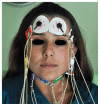Influence of vision on masticatory muscles function: surface electromyographic evaluation
- PMID: 25002919
- PMCID: PMC4071361
Influence of vision on masticatory muscles function: surface electromyographic evaluation
Abstract
The role of the ocular disorders (OD) in pathogenesis of MMp is still a controversal issue. Ocular arc reflexes (OAR) may involve changes in head and neck posture and generate modifications of contraction resulting in muscle contraction and finally weakness. sEMG tests were performed on 28 patients (13 with masticatory muscles pain and myopia/15 healthy) in rest position with eyes open and eyes closed. Patients group control (healthy patients) showed no significance difference in sEMG record in open/close test. In non healthy patients there were great differences between the sEMG recordings with eyes closed and open. Temporalis and masseters showed a statistical difference of means activation in two tests (temporalis p = 0.0010; masseters = 0.0006). Great difference there was in means muscles activation between open eyes healthy test and non healthy. No difference in close eyes test was evaluated in temporalis and masseters close test in the two groups. The exact causes of MMp are still unknown. The role how ocular disorders (OD) may play an important role in pathogenesis of MMp is still a controversal issue. Ocular arc reflexes (OAR) may involve changes in head and neck posture and generate modifications of contraction resulting in muscle contraction and finally weakness.
Keywords: masticatory muscles pain; ocular disorders; surface electromyography.
Figures



Similar articles
-
Effects of myogenous facial pain on muscle activity of head and neck.Int J Oral Maxillofac Surg. 2010 Aug;39(8):767-73. doi: 10.1016/j.ijom.2010.03.025. Epub 2010 May 2. Int J Oral Maxillofac Surg. 2010. PMID: 20439150
-
Occlusion, sternocleidomastoid muscle activity, and body sway: a pilot study in male astronauts.Cranio. 2006 Jan;24(1):43-9. doi: 10.1179/crn.2006.008. Cranio. 2006. PMID: 16541845
-
Surface electromyographic patterns of masticatory, neck, and trunk muscles in temporomandibular joint dysfunction patients undergoing anterior repositioning splint therapy.Eur J Orthod. 2008 Dec;30(6):592-7. doi: 10.1093/ejo/cjn052. Epub 2008 Nov 5. Eur J Orthod. 2008. PMID: 18990679 Clinical Trial.
-
Effect of the Enveloppe Linguale Nocturne on atypical swallowing: surface electromyography and computerised postural test evaluation.Eur J Paediatr Dent. 2010 Sep;11(3):141-5. Eur J Paediatr Dent. 2010. PMID: 21080755
-
Head and neck posture influences masticatory muscle electromyographic amplitude in healthy subjects and patients with temporomandibular disorder: a preliminary study.Ann Palliat Med. 2021 Mar;10(3):2880-2888. doi: 10.21037/apm-20-1850. Epub 2021 Mar 3. Ann Palliat Med. 2021. PMID: 33691457
Cited by
-
Experimental Analysis of the Use of Cranial Electromyography in Athletes and Clinical Implications.Int J Environ Res Public Health. 2022 Jun 29;19(13):7975. doi: 10.3390/ijerph19137975. Int J Environ Res Public Health. 2022. PMID: 35805630 Free PMC article.
-
The Influence of Visual Input on Electromyographic Patterns of Masticatory and Cervical Spine Muscles in Subjects with Myopia.J Clin Med. 2021 Nov 18;10(22):5376. doi: 10.3390/jcm10225376. J Clin Med. 2021. PMID: 34830655 Free PMC article.
-
The Organ of Vision and the Stomatognathic System-Review of Association Studies and Evidence-Based Discussion.Brain Sci. 2021 Dec 23;12(1):14. doi: 10.3390/brainsci12010014. Brain Sci. 2021. PMID: 35053758 Free PMC article. Review.
-
Effects of visual input on changes in the bioelectrical activity of the cervical and masticatory muscles in myopic subjects.Sci Rep. 2022 Jun 8;12(1):9435. doi: 10.1038/s41598-022-13607-1. Sci Rep. 2022. PMID: 35676313 Free PMC article.
-
How Does the Use of an Intraoral Scanner Affect Muscle Fatigue? A Preliminary In Vivo Study.Bioengineering (Basel). 2022 Aug 1;9(8):358. doi: 10.3390/bioengineering9080358. Bioengineering (Basel). 2022. PMID: 36004883 Free PMC article.
References
-
- Svenson J, Cowen D, Rogers A. Headache in the emergency department: importance of history in identifying secondary etiologies. J Emerg Med. 1997;15(5):617–21. - PubMed
-
- Silveira A, Armijo-Olivo S, Gadotti IC, Magee D. Masticatory and cervical muscle tenderness and pain sensivity in a remote area in subjects with a temporomandibular disorder and neck disability. J Oral Facial Pain Headache. 2014;28(2):128–37. - PubMed
-
- Schoenen J, Gerard P, De Pasqua V, Sianard-Gainko J. Multiple clinical and paraclinical analyses of chronic tension-type headache associated or unassociated with disorder of pericranial muscles. Cephalalgia. 1991;11:135–39. - PubMed
-
- Ashina M, Bendtsen L, Jensen R, Sakai F, Olesen J. Muscle hardness in patients with chronic tension-type headache: relation to actual headache state. Pain. 1999;79(2–3):201–5. - PubMed
-
- Jensen R, Rasmussen BK. Muscular disorders in tension-type headache. Cephalalgia. 1996;16:97–103. - PubMed
LinkOut - more resources
Full Text Sources
